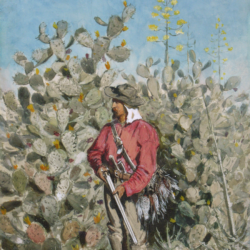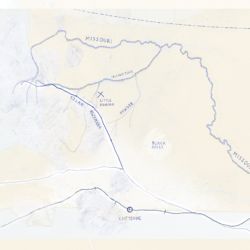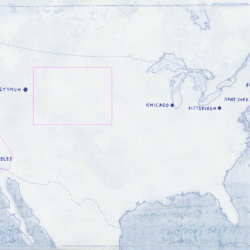
Trappers
The California of Sienkiewicz as described in Portrait of America seems to be stitched together out of two types of matter – the real and the idealized. If a stark division is to be applied, which always poses a risk, considering the real and the idealized are almost invariably intertwined in a literary image, then the real would be the one more strongly associated with the existing social relations and the idealized with the clash with nature. The clash with nature, the colonization of wilderness, is, after all, something Sienkiewicz expected, something that was accompanied by the legend of the American frontier of the trappers and bears, which Sienkiewicz bore in memory when he came to the States. For this reason, it is the Californian fragments of Portrait of America that feature the most complete interlacement of the idealized model of a European encounter with the American wilderness and genuine rapture and amazement, that is a combination of imagination and experience.
That idealized element is apparent not only in the composition structured around Sienkiewicz turning into a true trapper but possibly even more in the image of the trapper itself. For in point of fact, within the reality of California of the end of the 1870s, trappers were a species on the verge of extinction.
To be exact, the end of the trapper line of work in the West occurred almost two generations before. The last trapper gathering, signaling the end of the profession, the customs and ethics associated with it, was convened in 1840.[1] Trappers, that is hunters specializing in hunting fur animals and selling their hides (that is where their name comes from, the traps that they set), lost their place in the market in the 1840s, both because of the lack of supply (too many animals killed, especially beavers) and demand (market saturation). The most renowned among the ones who stayed in the West became guides helping to blaze new trails for the settlers and often working for the railway or the army. Among them was Kit Carson, a key character in the mythology of the West.[2] In 1876, when some of the conquerors of the West were barely beginning to forge their own legend (Wild Bill Hickok died six months after Sienkiewicz came to the States) or have not appeared on the scene yet (Wyatt Earp is to gain publicity only after 1878), Kit Carson, deceased in 1868, was the most emblematic character in the mythology of conquering the West. Emblematic as a trapper-guide, an infallible hunter and scout, a mountain man parading in animal hide, an unerring sharpshooter, blazing the United States’ trail to the West.
Carson’s merit was singular as he was the guide of Col. John C. Frémont’s third surveying expedition (the previous two as well). The expedition, in fact, turned into an anti-Mexican uprising in California, which later on with the support of the US fleet and infantry led to the acquisition of California by the Americans. This campaign, as it often happens with victorious ones, abounded in events that were to become the stuff of legends – the Californian flag is just one of the outcomes (the bear which Carson and Frémont saw once they reached the coast), another is the name the entryway to the port of San Francisco, i.e. the Golden Gate (Frémont is said to have uttered these words upon seeing the strait, yet untouched by human hand, at sunrise).[3] Carson’s most famous feat during the California expedition (already at the time of armed conflict) was to walk thirty kilometers on foot with no shoes on in twelve hours to ask for reinforcements which allowed the American troops to egress the most critical situation of the entire campaign.[4]
Since the 1850s, many of Carson’s achievements, often invented, became the canvas of popular literature of the lowest quality and widest circulation, which made him the most recognized hero of the West.[5] Apart from that, Sienkiewicz could also have known a piece of writing which was almost equally widely read even though it was much more serious, bearing a title quite unusual for a bestseller: Report on the Exploring Expedition to the Rocky Mountains in the Year 1842 and to Oregon and North California in the Years 1843–44. As the name itself suggests, technically it was a report on the first two expeditions made by Frémont to the United States Congress. This little text with a sensational plot and narration resembled an adventure novel rather than a report,[6] and even in the 1840s, it lived to see three reprints. Quite possibly, it is there that we should look for some narrative clichés characteristic of Wild West stories, especially the character of a newcomer, outsider, who – with help from a “smart simpleton” knowing the wilderness inside and out – becomes the hero of the new territory. This is how Frémont is stylized in the report (the role of the “smart simpleton” falls to Carson, of course).
A distant trace of that model can be found on the pages of Portrait of America.[7] Sienkiewicz, admittedly, treats himself more modestly than Frémont, one certainly cannot speak here of such a far-reaching heroization, there is no clear “untaught master” embodied by Carson, nevertheless, for all other intents and purposes the pattern of a journey to the West as a rite of passage is similar, the definition of the canon of male qualities is also similarly defined. It is in this narration and in similar ones – generally contemporary and perceived as accounts reflecting true events – that one should look for the sources of Sienkiewicz’s American text rather than in, for instance, Cooper, in whose writing the white protagonist is, from the onset consistently a man of two cultures (it is a still different matter that the author of the Frémont Report, whoever that person may be, was definitely indebted to Cooper in their description of Carson, different though the type of hero may have been). This model – becoming a “man of wilderness” not to reject civilization but to become a man of two cultures, a transmitter of European values and a real male able to withstand any challenge – is going to appear later on in Polish literature, especially in On the Mountain Pass (Na Przełęczy, 1891) written by Sienkiewicz’s friend, Stanisław Witkiewicz, in which the entire narrative structure built around the hero-narrator is like a mirror image of the one in Portrait of America.[8]
The question should be asked, does not a similar process take place in the universe of the Trilogy, notably on the pages of With Fire and Sword (Ogniem i mieczem). All the heroes – Skrzetuski (Skshetuski), Wołodyjowski (Volodyovski), Zagłoba, Podbipięta (Podbipyenta) – are newcomers who have arrived from different parts of the Commonwealth. The attempt to make a life within the borderlands of Poland brings out the best qualities in each of these characters, nonetheless, they are not transformed into someone different. Most importantly they are not transformed into men of the wilderness. It would seem, however, that without having victoriously conquered the wilderness of the borderlands none of them could have fully become a knight of the Commonwealth.[9]
The fascination with the world of the trappers possibly consists then of a few layers. Undoubtedly Sienkiewicz’s trapper – through the image of Carson – bears the characteristics of a conqueror of the frontier, not just a hunter chasing beavers. Inevitably, he is notwithstanding also a hunter tracking beavers. That is – he bears the characteristics of the American frontier era, which is coming to a close. Portrait of America seems to carry a not unrelated meaning in a passage that describes a journey through the desert with a Native American from a dying tribe.[10] For all the patronization the character of the Indian receives, the excerpt carries a feeling of nostalgia for a world that is passing away and with which Sienkiewicz, in fact, was never able to become acquainted. Another issue raised by Sienkiewicz, though only signaled in passing, is the awareness of the destruction of American frontier culture of by the progressing civilization. As if Sienkiewicz wished for the conquest of the West never to conclude. It seems that the way Sienkiewicz portrays the ethos of the trapper is exactly that kind of hoping against hope to stop the inevitable, an attempt to freeze the process of conquering the West in an everlasting Now. Finally, another issue is the here and now, the feeling that the process of conquering the West remains ongoing and that the trapper education that Sienkiewicz receives in California makes him a part of that process and maybe even a transmitter of the trapper ethos.
Przypisy
- Ibidem, p. 62.
- Hampton Sides’s Blood and Thunder is a popular yet excellently documented monograph of Carson, which thoroughly encapsulates the current state of research.
- Ibidem, pp. 116–117.
- Ibidem, pp. 241–245.
- Ibidem, pp. 273–280.
- Currently, it is widely believed that its co-author was Frémont’s remarkable wife, Jessie Benton Frémont, considered to be one of the keenest minds in Washington of that day.
- I specifically mean “letters” no. 8 and 9 (Szkice amerykańskie [Sketches of America], the second with the subheading: “Z puszczy” [From the jungle]), introducing the author as a student of the trapper art. See also the letter to Edmund Leo from September 1876: H. Sienkiewicz, Listy [Letters], vol. 3, pp. 450–455.
- Nota bene, Witkiewicz is the author of the heroicized portrait of Sienkiewicz shown as a hunter in the Californian desert.
- It is worth mentioning here that a similar ethics of an armed statesman in the service of the nation, burdened with a historical mission appears in Frémont’s narration – as opposed to Sienkiewicz’s much less bombastic Portrait of America or Witkiewicz’s Tatra mountain accounts.
- Compare Robert M. Utley, Frontier Regulars: The US Army and the Indians, 1866–1891, Bloomington 1977 (1st edition, New York 1973), pp. 44–58; pp. 111–115.














